In the second of four articles exploring the Department for Infrastructure’s (DfI) review of the Alfred Street cycleway, Bikefast looks at implementing the glaringly obvious, slap-you-in-the-face, bare minimum solutions – the ones which DfI should have already rolled out to keep users safe and stem the tide of criticism of this worthwhile project.
How we got the brink of fixing Alfred Street
Strange as it sounds, two years of simmering dissatisfaction finally boiled over due to a positive aspect of DfI’s shepherding of new cycleways. In August 2018 a series of sewer works engulfed the Ormeau Avenue end of Alfred Street. Rather than what cyclists are typically faced with during road works (see: Cyclists Please Dismount), DfI worked with Northern Ireland Water to establish a temporary cycleway diversion for the duration of the works.
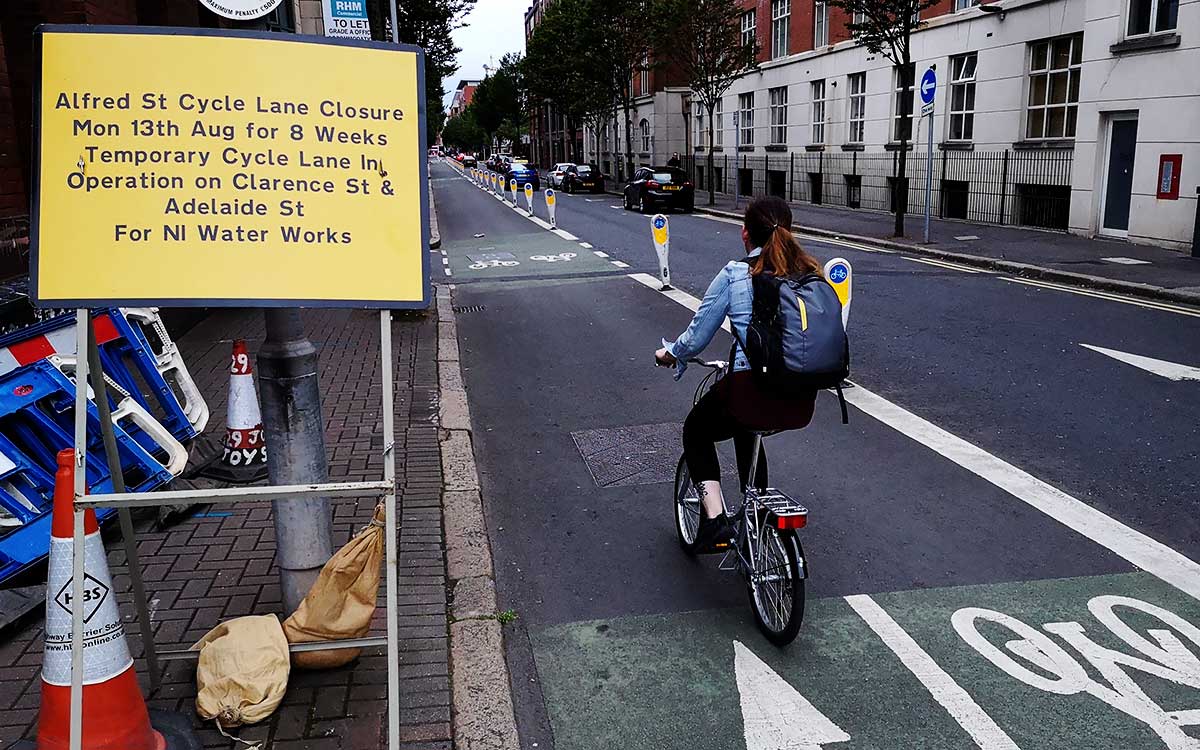
And that temporary cycle lane wasn’t just going to be a few signs. DfI was rightly applauded for making the diversion a fully protected route using barriers to separate users from traffic on streets unused to high cycling levels. Six on-street paid parking bays on Clarence Street and 19 on Adelaide Street were sacrificed in favour of active travel. It was a big, bold statement.
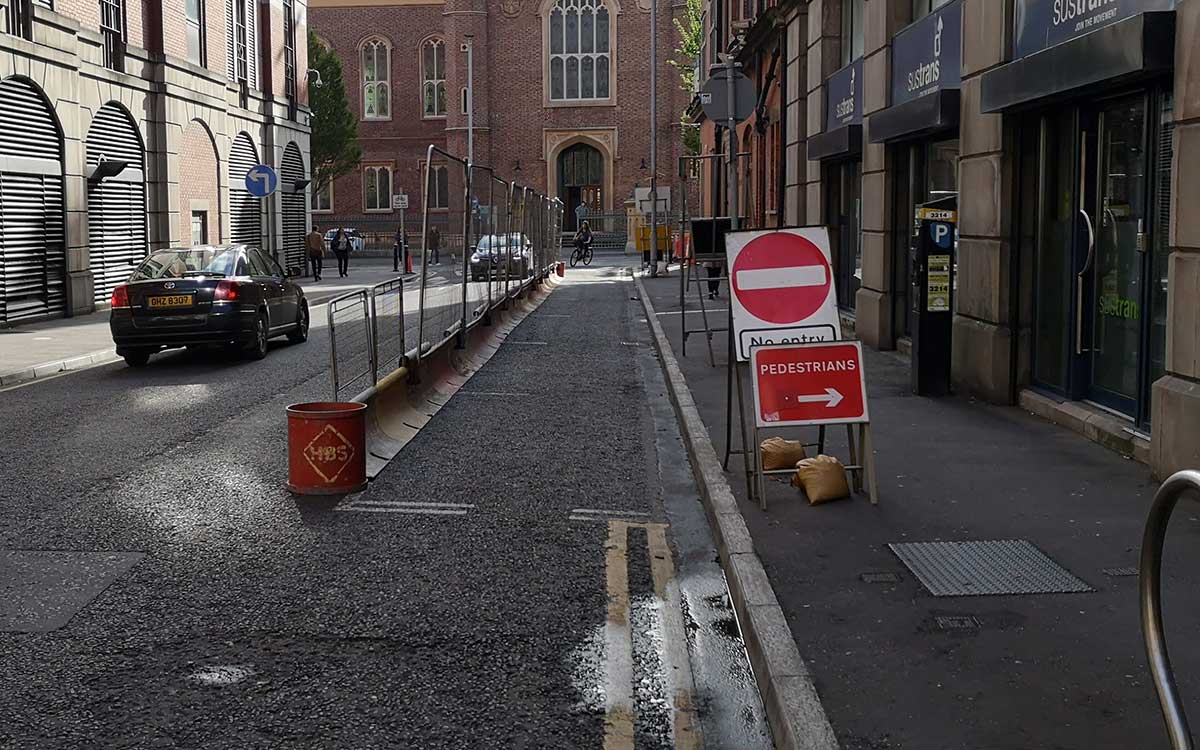
There was just one problem with this. The protection was better than the real thing, exposing the failings of the cycleway it was replacing. Welcome as the diversion was, if DfI recognised the need to completely exclude vehicles from it with an impenetrable barrier, what did that say about their Alfred Street wand set-up?
Hey, @deptinfra – how come the temporary cycle lane on Adelaide provides better protection than the permanent one on Alfred Street? And chance of fixing Alfred St? @nigreenways @belfastcc pic.twitter.com/0EVKNoLXDd
— TBSteve (@TBStevesPix) August 16, 2018
So letters were sent highlighting the golden opportunity presented by the removal of cycleway wands to facilitate the sewer works – why not just install wands at three metre spacing when the contractor was putting them back in?
Alfred St cycleway progress:
– resurfaced ✔️
– repainted ✔️
– separation wands ✖️A month ago we highlighted the chance to replace wands *the right way* (to prevent vehicle incursion @ minimal cost to public purse) & requested a meeting with @deptinfra.
Still no word. Too late? pic.twitter.com/whL8lIhxfZ
— NI Greenways (@nigreenways) October 15, 2018
But the answer was no and the cycleway wands were restored in their original places.
In reality it took the combined intervention of the Northern Ireland Assembly All Party Group on Cycling, represented by MLAs Chris Lyttle (Alliance), Claire Hanna (SDLP) and Philip McGuigan (Sinn Féin), Sustrans and Bikefast to gain traction and lead us to the review we’re now examining.
Thanks @nigreenways for organising meeting btw @deptinfra , @SustransNI & All Party Group on Cycling. Primarily about pressing need for additional wands in ‘protected’ city centre bike lanes, but more broadly about how cycling can be better supported & planned for in development pic.twitter.com/sJHdT3NvPS
— Claire Hanna (@ClaireHanna) October 26, 2018
The review itself is now open to the public for comment on the operation and maintenance of the Alfred Street cycleway and its related schemes – you can find the link at the bottom of the article. Bikefast has two solutions; an easy fix or radical change. We’ll explore the latter in the final article, but if DfI are determined to keep the cycleway in place and tinker around the edges, here is what they need to do.
Cycleway-wide fixes
To summarise the issues covered by the first article, the cycleway was not constructed as it was presented in the public consultation – this was problematic because objections would have been raised to catch these problems before they occurred.
There are three fundamental design errors which undercut the protection along the entire cycleway, and each has a simple solution:
PROBLEM 1: Gaps between wands are too wide allowing drivers access at any point along the cycleway
SOLUTION: Place wands at three metre frequency instead of six metres
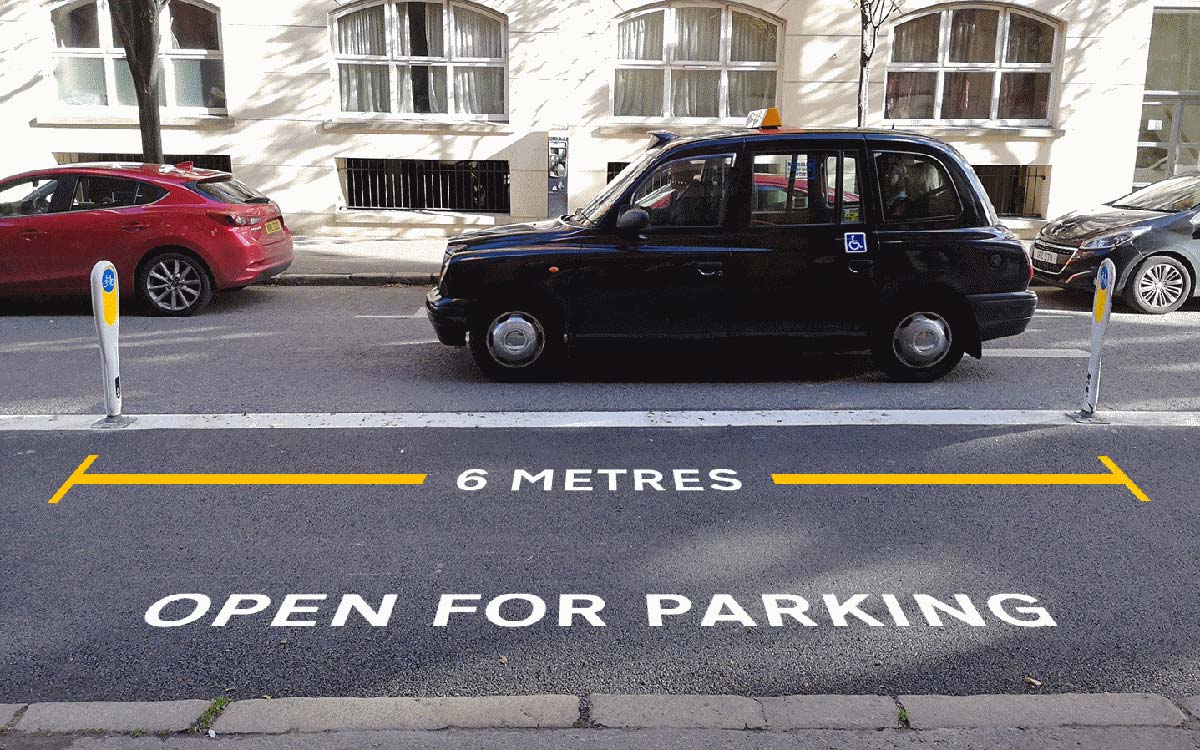
This is the least controversial of the suggestions. It should have been done from the start. It was a dreadful failure of critical thinking (and death by committee) to design a protected cycleway which permits vehicles to turn in wherever they want.
It also wasn’t a matter of cost because..
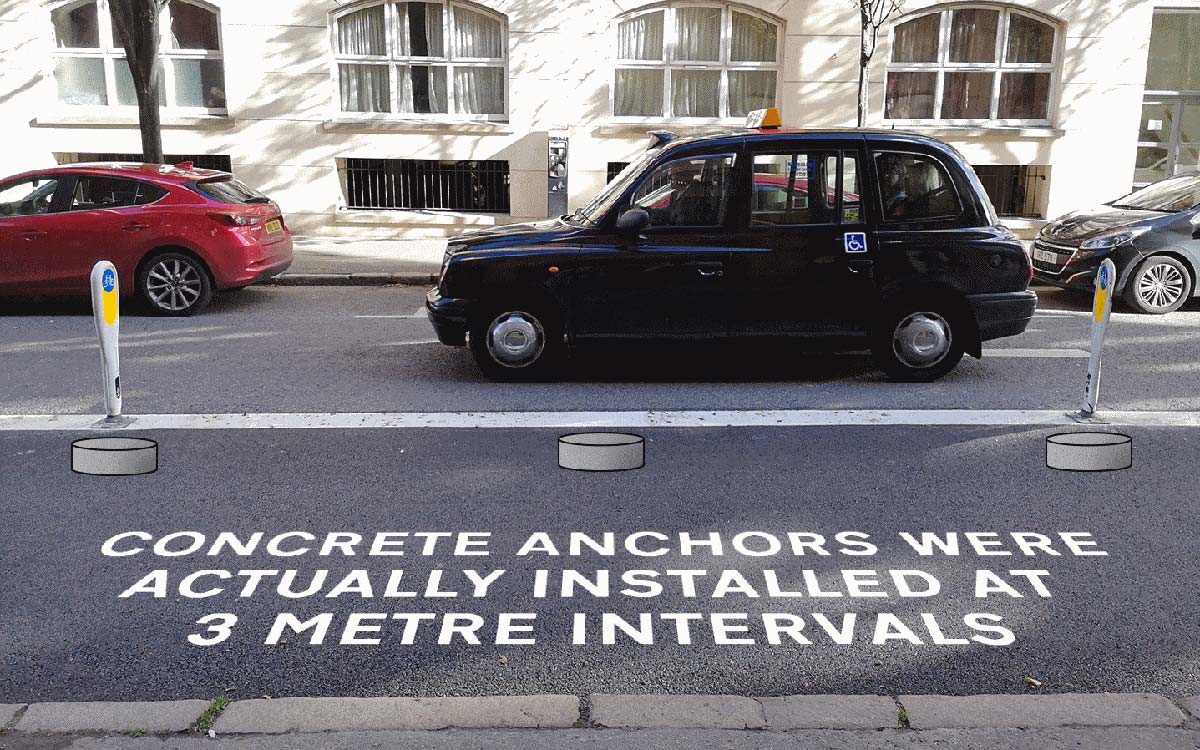
So the fix amounts to procuring:
- 60 wands
- 240 bolts
- a contractor to install them
And suddenly we’ll have this, as modelled by our glamorous cone..
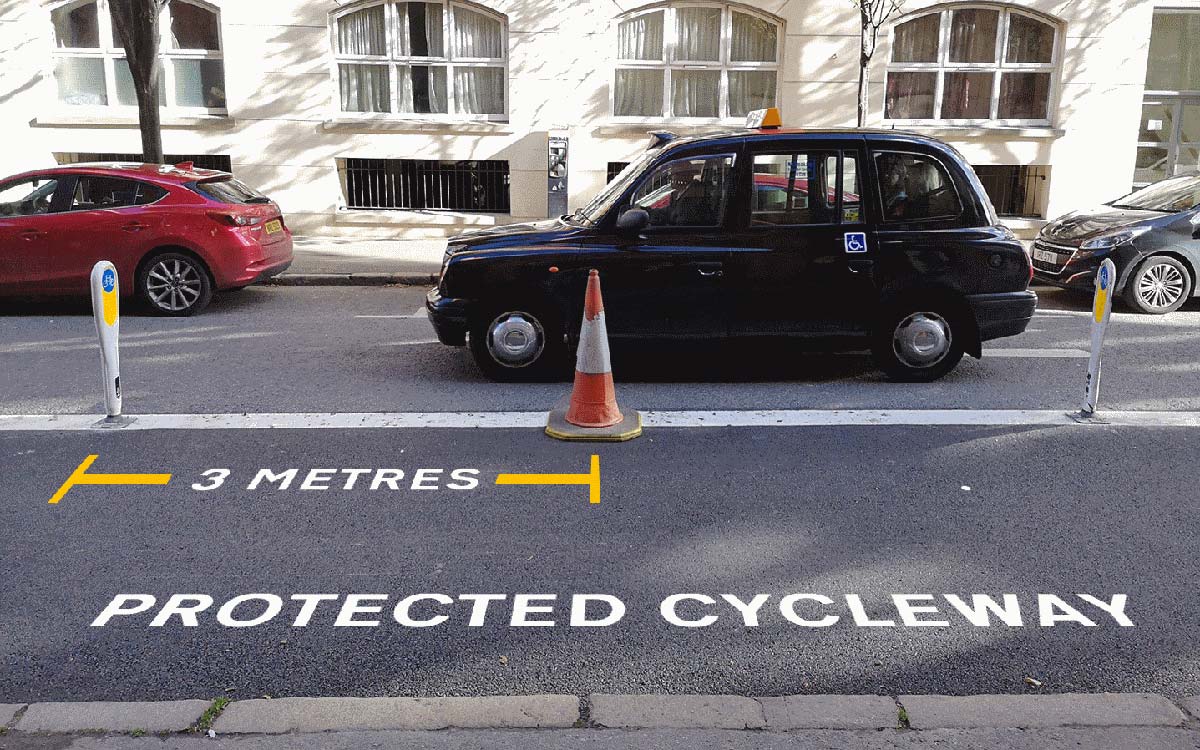
If this change doesn’t happen by the end of the 2018-19 financial year, DfI will have shown itself unfit to manage cycling schemes in Northern Ireland.
PROBLEM 2: Drivers can enter the cycleway at side entrances and junctions and simply driving along
SOLUTION: Place gate wands in the centre of the cycleway

Photoshopped image of how gate wands would close off the cycleway to vehicles
‘Gate’ wands need to be placed at unprotected entry points, preventing people (accidentally or intentionally) entering the cycleway when turning from Clarence Street and Franklin Street.
I wanted to capture some sense of the traffic levels crossing the cycleway at Franklin St / Sussex Place (foreground) but then one outcome of @deptinfra's poor implementation made my jaw drop – RT when you see it pic.twitter.com/VMralljwxP
— NI Greenways (@nigreenways) December 13, 2018
I can try to explain the case as best I can with words, but that video, captured just last week, should shame DfI into action.
PROBLEM 3: Poor wand placement creates swept junction turns increasing vehicle speed and risk of collision
SOLUTION: Restrain vehicle turns by placing wands closer to junctions
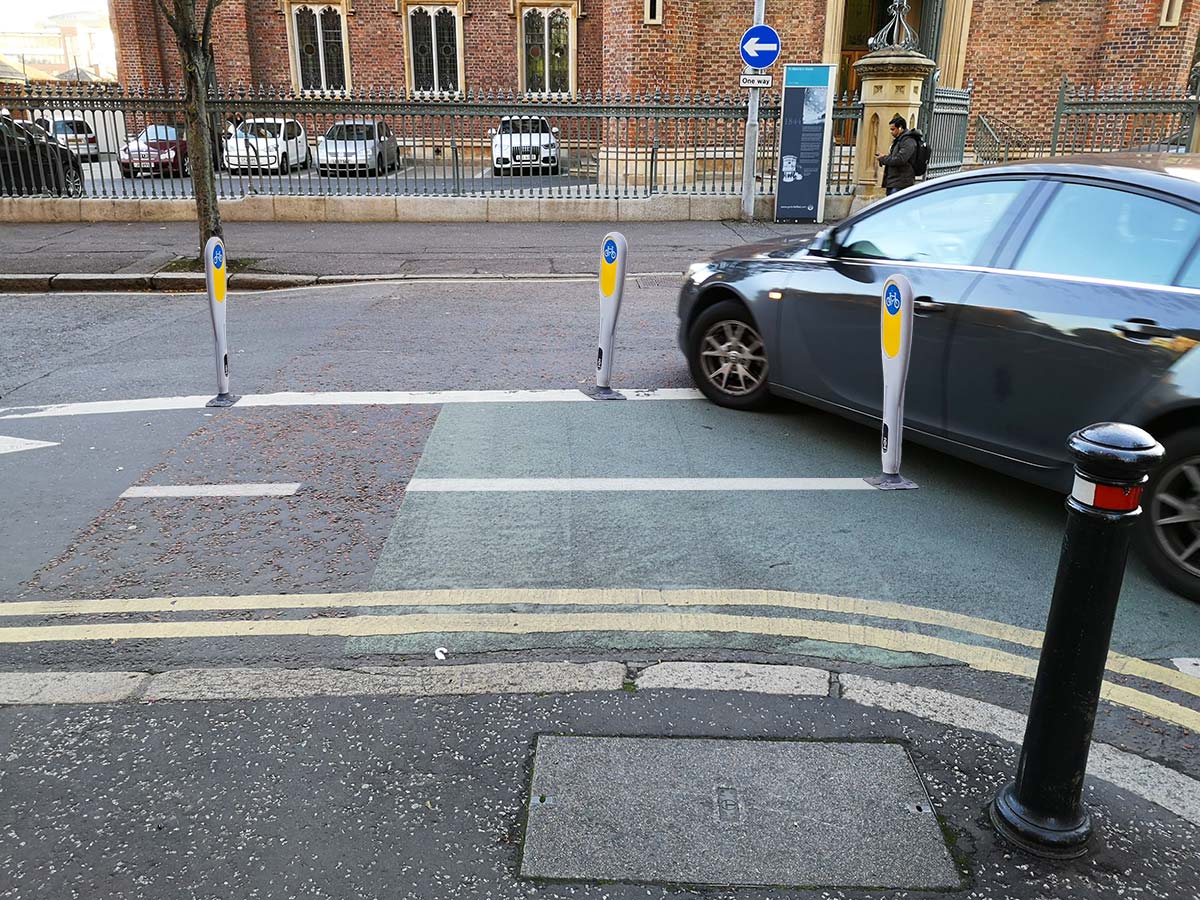
Photoshopped wands showing how this car turning at speed would be forced to turn at a sharper, slower angle
Wands have generally been set too far back from junctions allowing wide (and fast) turns into and out of side streets. Placing wands closer restrains speed and encourages better vigilance of cyclists and pedestrians on the street.
Location-specific fixes
Taking the main areas of concern identified in the first article, let’s apply these three solutions and look at other simple measures which will improve Alfred Street’s current set-up:
Ormeau Avenue
(Use the PREV and NEXT buttons to compare current and proposed layouts)
Converting the priority of the level footway away from vehicles towards pedestrians and cyclists is essential here, but would require significant remedial work so can’t be classed as a “simple fix”. We’ll address it fully in our fourth article.
The addition of cycleway separation wands at three metre spacing begins here and will continue all the way to Chichester Street.
At the entry behind Tyrone House, the first set of ‘gate’ wands are implemented. This is a single wand in the middle of the cycleway and, if needed, another wand on the footway kerb line to prevent vehicles encroaching from this side.
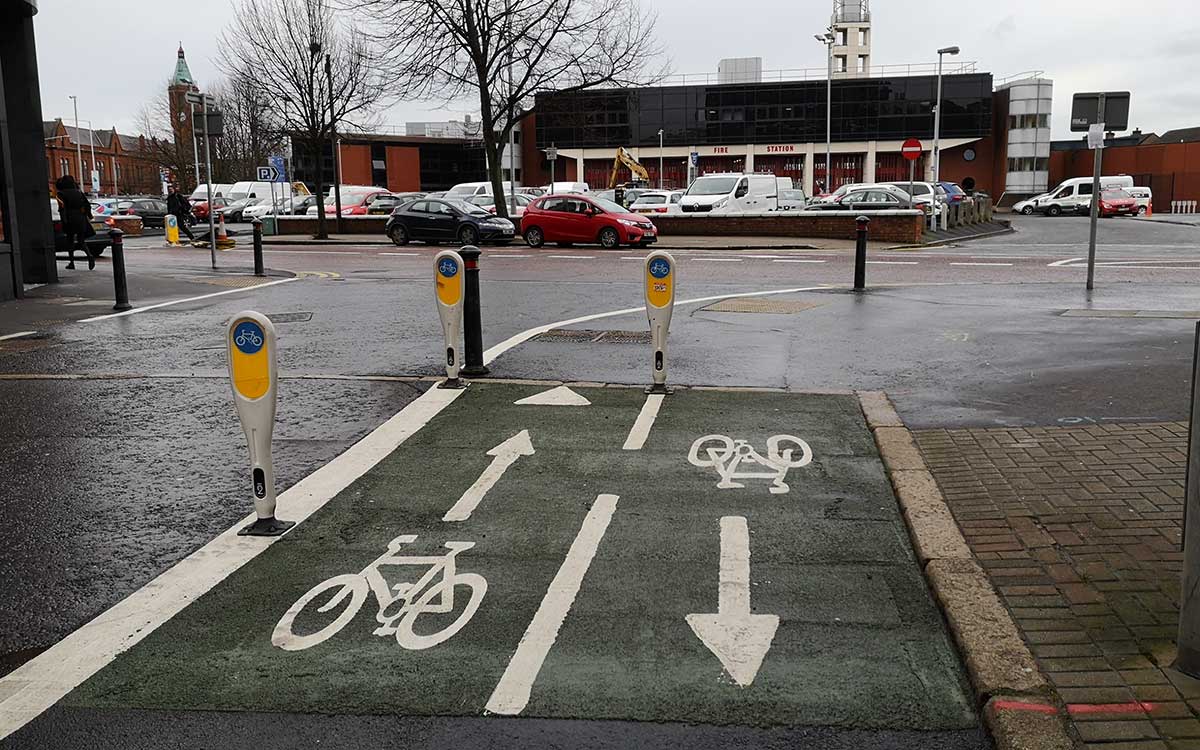
If central ‘gate’ wands are good enough for slowing cyclists at Ormeau Avenue, they’re good enough to controlling vehicles elsewhere
These gate wands are positioned at enough of a distance from the final separation wand to allow space for council cleaning vehicles to enter – which was a failing of the central bollards on the old ‘Bin Lane’ – but not cars.
Adelaide Exchange car park
Gate wands here would again prevent potential vehicle movements along the cycleway.
The broken white line of the cycleway at the car park entrance means it’s technically okay to block the cycleway, so demand management is essential. Recognising the need for dedicated commercial parking, loading bays are provided opposite the entrance.
This includes a dedicated area for temporary storage of commercial bins before and after collection times – this will support building operations in Adelaide Exchange and reduce instances of bins remaining on the cycleway, footway or car park entrance.
One of the major problems & easy fixes if (big if) @deptinfra decide to retain this current set-up on Alfred St – here's DB Schenker doing the right thing (not blocking the cycleway) but without dedicated loading bays (where the skip is), other drivers make the cycleway lethal. pic.twitter.com/5YnZMQBQum
— NI Greenways (@nigreenways) December 6, 2018
The high number of daily taxi movements generated by the 148 room Premier Inn doesn’t seem to have factored into the original cycleway design. The review must address this to the benefits of taxi drivers, hotel customers and the owners by providing dedicated taxi waiting space.
Clarence Street
Control of speed and turning radius is the key here – gateway wands will prevent the common move of reversing into the cycleway for handy parking. The tweet below shows the Franklin Street turn instead of Clarence Street, but perfectly demonstrates the shallow angle of turn favoured by too many drivers.
(Snow is great.) Like @StripyMoggie says, without the originally planned bollard (where the red arrow is) drivers just cut this corner and turn at higher speed, placing cycleway users at greater risk. Bad implementation by @deptinfra, still not rectified. https://t.co/ym2XmL2XJz pic.twitter.com/OjL3wmXMEm
— NI Greenways (@nigreenways) March 1, 2018
Placing the final wand closer to the corner forces drivers to approach slower and turn more sharply, naturally providing a good driver with extra time to check for pedestrians and cyclists.
Adding wands around the access points to DfI headquarters again makes the cycleway safer, but critical to safety here – and the first major traffic intervention proposed – is the stopping up of Russell Street. This prevents DfI staff from rat-running around residential streets and will help (even if in a small way) to make the car a less convenient option for those tasked with convincing the rest of the country to travel more sustainably.
Franklin Street / Sussex Place
The major mistake of the original cycleway scheme was to put the sticking plaster of a segregated cycleway onto a street utterly broken by unnecessary vehicle traffic. The point where this is best seen, and creates the most danger, is the junction with Franklin Street and Sussex Place.
Stopping up Franklin Street was verboten then – Bikefast has asked repeatedly – but it can’t be now. It only serves to encourage drivers to cross the city through a residential area, slingshot around the City Hall towards the east in the evening, and itself feeds the addiction of drivers constantly circulating for empty on-street parking by hosting six paid bays.
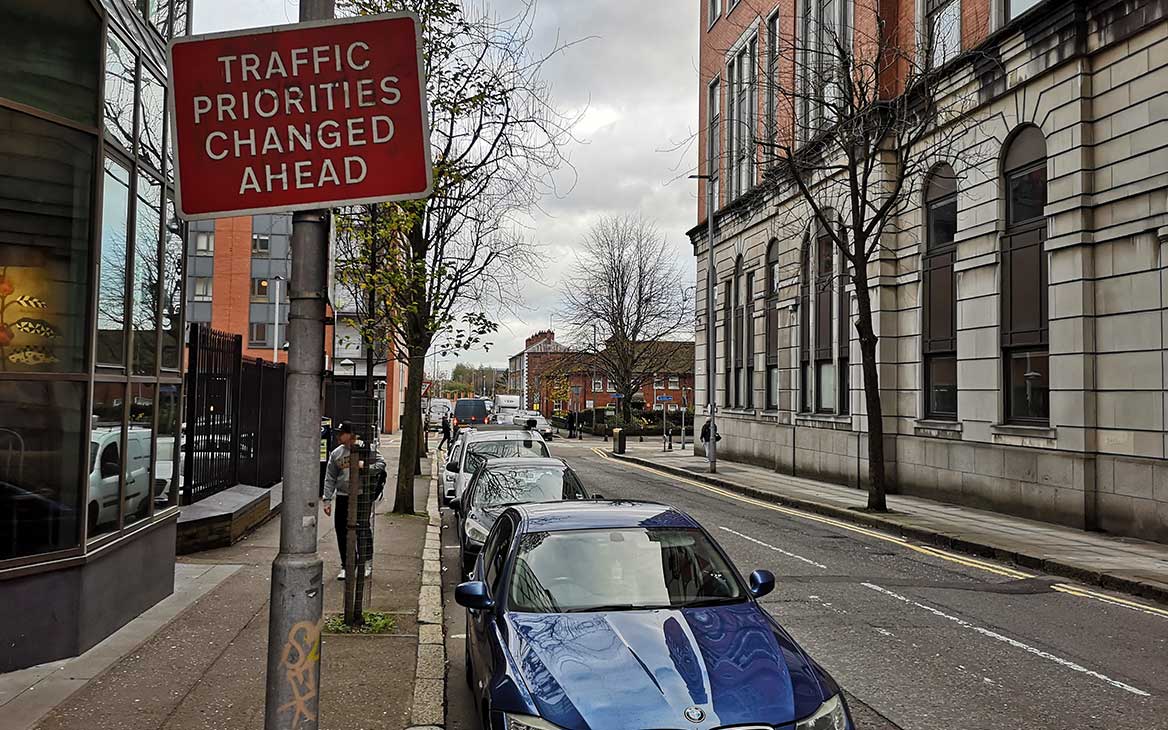
Does DfI have the guts to put PfG outcomes ahead of car traffic and close this section of Franklin Street?
Close the street off to vehicles and you instantly cut traffic levels across the entire Linen Quarter, reduce cycling conflict at this junction, and make Alfred Street as a whole a more pleasant environment. The Department has already schooled cyclists in the exact mechanism at its disposal to run a year-long trial – the Experimental Traffic Control Scheme, used to attempt to shoehorn thousands of private hire taxis into Belfast’s bus lanes earlier this year. Why not put it to use in support of sustainable travel, instead of trying to kill it?
Tightening the north-east corner at Sussex Place would prevent drivers exiting the private car park from cutting unlawfully back against the one-way flow to head east – another simple and needed discouragement to car travel.
DfI must recognise the high demand for loading space outside the Northern Ireland Housing Executive, and the potentially lethal consequences of not providing it.
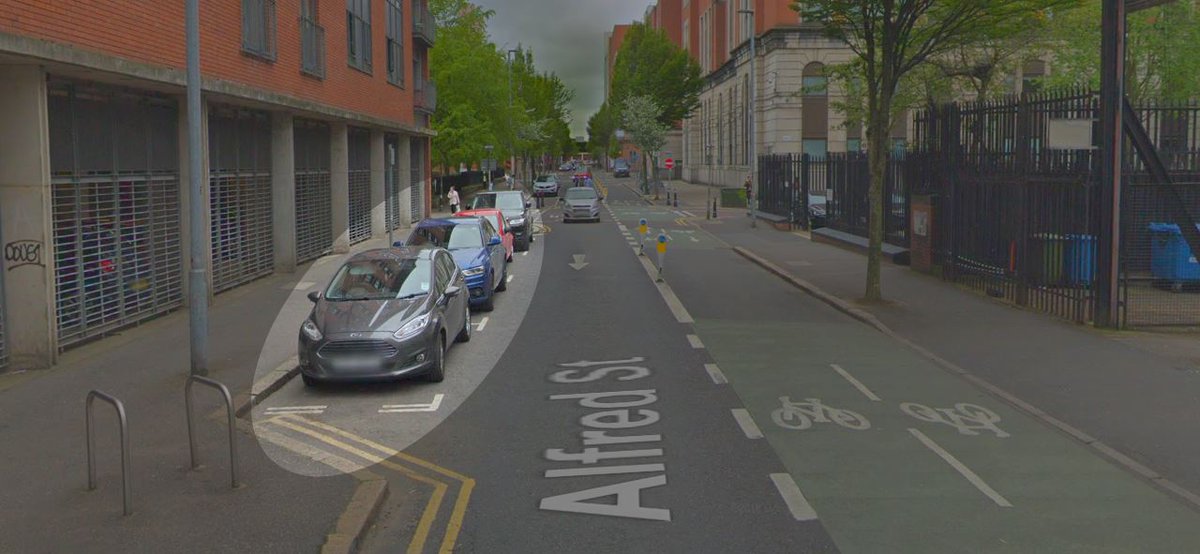
The standard fix when loading is in high demand – swap these parking bays for loading bays © Google 2018
We can either continue to wring our hands at the constant blocking by vans and trucks, or we can support workers by providing them with the space to do their jobs in a way which is safe for them and others. All for the price of four fewer paid parking bays.
May Street
The problems of driver behaviour at the May Street junction are clear and to be fair DfI have reacted at several stages since early 2016 – from additional signage, to a semi-permanent VMS system to painting the cycleway crossing. Nothing deters drivers.
Bringing wands right up to the edge of the May Street carriageway could further reinforce the need for drivers to continue straight on. But to be blunt, in an article outlining simple fixes to this cycleway, there is no simple fix to this issue. A costly solution is to install a camera system to detect movements and issue penalty notices to drivers – but its unlikely to eradicate the problem, as the ongoing level of fixed penalties triggered by a bus lane camera on the parallel Adelaide Street / Donegall Square East junction shows.
You could easily make the problem disappear by just stopping up the street, but DfI remains conflicted by its twin aims of traffic progression and growing active travel – the former always wins out in these circumstances. There is a straightforward solution, balancing all needs, which Bikefast will outline in article four.
Summary
None of these fixes should be shocking or outlandish to Department for Infrastructure road engineers or senior management. What would be shocking is any further deferral of action to address clear problems for all users of Alfred Street.
The whole length of this street is one way for vehicles. That means, if a vehicle blocks the cycleway, half of the bicycle users must either dismount and walk or cycle against the flow of traffic. It should be a foundation of any cycling infrastructure which is claimed to be protected that users should face the absolute minimum of contact with vehicle and traffic. Where modes do mix, clear priority should be given to more vulnerable users and vehicle traffic restricted as much as possible.
In the next post we’ll look at the surprising news that DfI are planning an extension of this cycleway along Hamilton Street (off the Sussex Place junction) while this review is taking place. Have the implications been fully thought through and is there any wider strategy behind it?
The Department is seeking your views on “what improvements can be made to the operation of Alfred Street and Upper Arthur Street in line with the draft Programme for Government”.
Send your views on the Department for Infrastructure’s Alfred Street cycleway review here.
Alfred Street review articles
Alfred Street cycleway review – the issues
How to fix the Alfred Street cycleway
Extending a cycleway along Hamilton Street?














[…] in the city. Hamilton Street would barely register in terms of open public concern. Coupled with two years of (official) silence from DfI on the Alfred Street cycleway problems, let alone expansion, the Hamilton Street scheme came out of the […]
[…] How to fix the Alfred Street cycleway […]